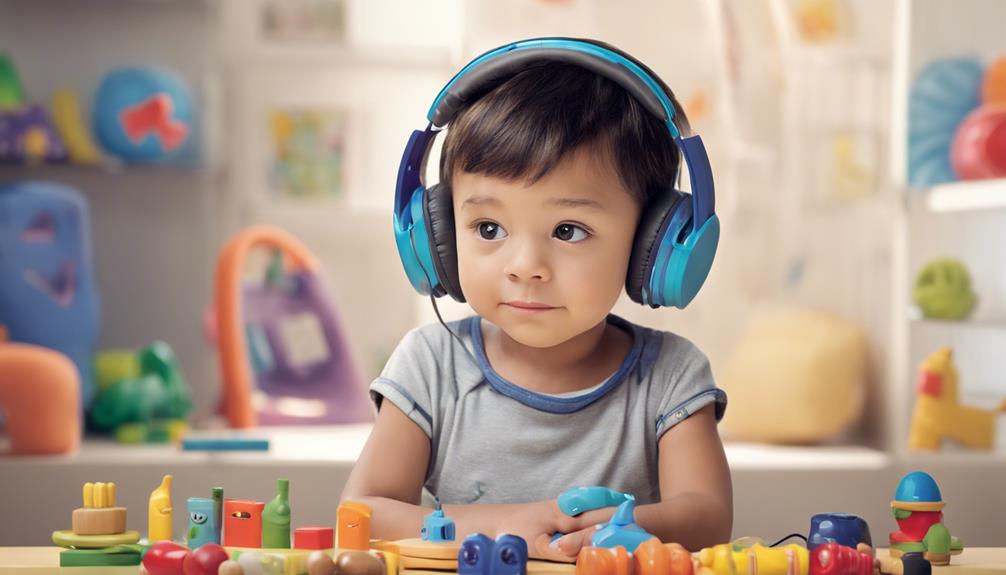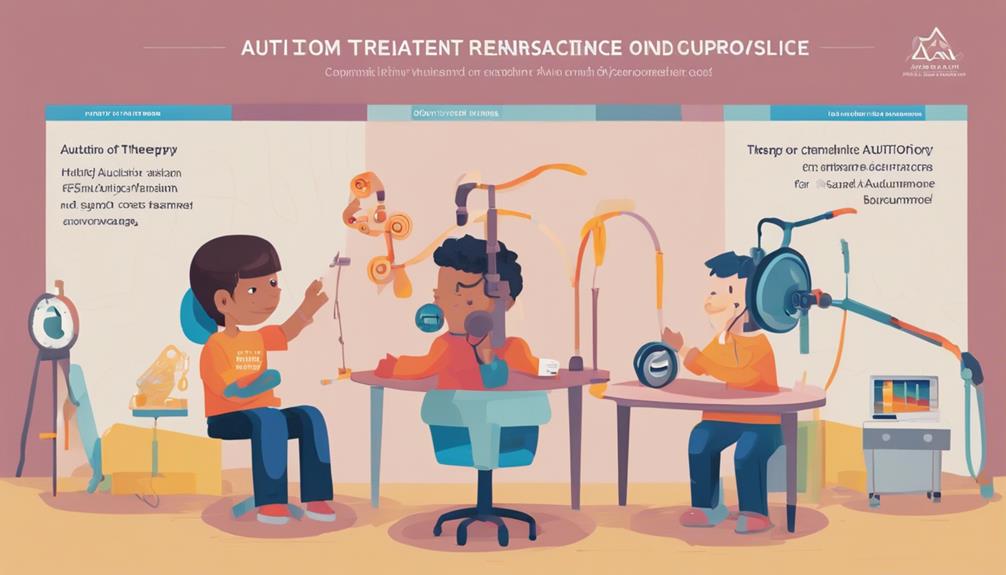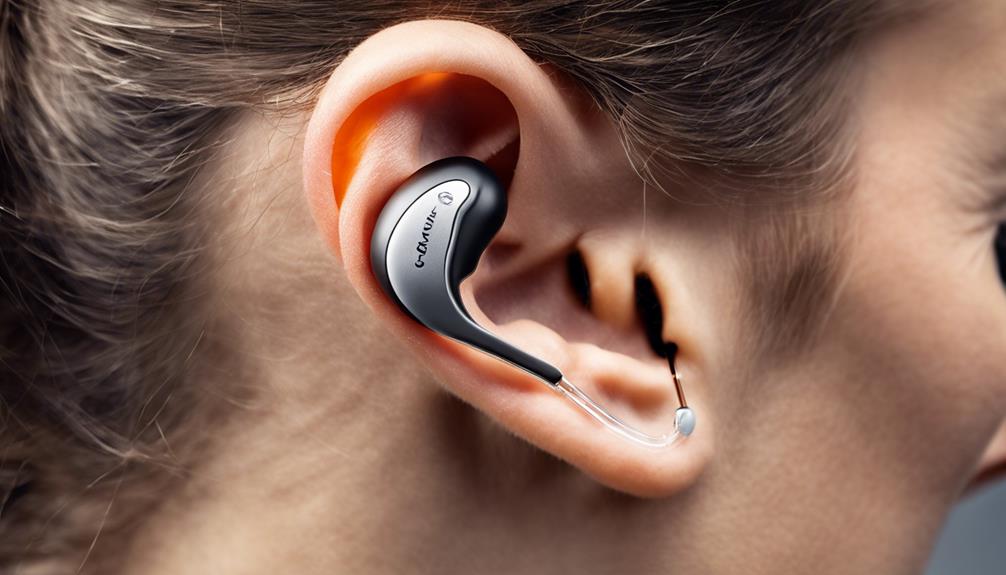When exploring the multitude of autism treatment choices, auditory therapy shines as a promising option. Its capacity to tap into the intricate workings of sound processing in those on the spectrum raises questions about its potential benefits.
The nuanced approach of auditory interventions may hold the key to unlocking new avenues of support for those with autism.
Key Takeaways
- Improves sound sensitivity and processing, crucial for individuals with autism.
- Enhances communication skills and social behavior through targeted auditory interventions.
- Customized auditory programs address sensory issues effectively.
- Offers hope for improved attention to auditory input and overall quality of life.
Benefits of Auditory Therapy for Autism
Auditory therapy for autism offers significant benefits by improving sound sensitivity and processing irregularities in individuals with Autism Spectrum Disorder (ASD). Sound sensitivity is a common challenge for many individuals with ASD, making everyday noises overwhelming and distressing. Through interventions like auditory integration training (AIT), individuals can experience a reduction in distortions in hearing, leading to enhanced communication skills and social behavior.
Sensory issues are a hallmark of autism, and auditory therapy plays a crucial role in addressing these challenges. By participating in programs like AIT, Tomatis method, or Samonas sound therapy, individuals with ASD can improve their ability to process and respond to auditory stimuli effectively. This improvement in sensory processing can lead to better attention to auditory input, promoting social behavior and enhancing academic skills.
Understanding Auditory Integration Training (AIT)

During Auditory Integration Training (AIT), individuals with autism spectrum disorder (ASD) undergo specialized sound therapy sessions designed to reduce sensitivity to sounds and enhance sound processing abilities. AIT, also known as Auditory Integration Therapy, aims to address sensory problems related to hearing in individuals with autism.
Here are three key points to consider when understanding AIT:
- AIT involves intensive sessions: Participants typically engage in 30-minute AIT sessions twice a day for 10 consecutive days. This intensive schedule is designed to gradually expose individuals to modified music to help alleviate sensory challenges associated with auditory processing.
- Individualized approach: AIT is tailored to meet the specific needs of each participant. By customizing the sound therapy experience, practitioners aim to provide targeted intervention that addresses the unique sensory issues present in individuals with autism spectrum disorder.
- Supervision and safety: It's crucial for healthcare professionals to closely monitor individuals undergoing AIT to ensure safety and prevent potential hearing concerns. Regular oversight during the therapy process can help mitigate risks and optimize the benefits of auditory integration training for individuals with ASD.
Effectiveness of Auditory Therapy
When considering the effectiveness of auditory therapy for individuals with autism, it's crucial to look at:
- Therapy success rates
- Patient improvements noted
- The expertise of therapists
Understanding the nuances of how therapy impacts individuals can provide valuable insights into its potential benefits.
While research may offer varying perspectives, recognizing the importance of:
- Individualized approaches
- Skilled practitioners
is key in navigating the complexities of auditory therapy for autism.
Therapy Success Rates
Preliminary research findings suggest a need for further investigation into the effectiveness of auditory therapy in improving core symptoms of autism. When considering therapy success rates, it's essential to acknowledge the complexities involved in treating individuals with sensory processing issues. Understanding the varying treatment responses and the nuanced impacts of auditory integration therapy (AIT) can guide us in better supporting those on the autism spectrum. While the efficacy of auditory therapy remains under scrutiny, ongoing research offers hope for potential benefits.
The quest for improved therapies demands our unwavering dedication to exploring innovative solutions. Empathy and understanding are crucial in addressing the diverse needs of individuals with autism. Collaborative efforts in research and practice are key to advancing autism treatment methodologies.
Patient Improvements Noted
Numerous studies have demonstrated notable improvements in sensory processing, attention, communication, and social behavior among individuals with autism spectrum disorder (ASD) following auditory therapy. This form of therapy has been associated with enhanced auditory processing skills, reduced sensory sensitivities, and improved emotional regulation in individuals with ASD. Those undergoing auditory therapy often experience increased focus, decreased anxiety, and enhanced self-regulation abilities.
Positive outcomes may include better language development, increased social interactions, and decreased behavioral challenges. Research indicates that interventions in auditory therapy can lead to significant enhancements in adaptive skills, cognitive abilities, and overall quality of life for individuals with ASD. The evidence supporting the effectiveness of auditory therapy in improving various aspects of ASD is compelling and offers hope for those seeking interventions in this area.
Therapist Expertise Crucial
In the realm of auditory therapy for autism treatment, the expertise of therapists plays a crucial role in determining its effectiveness. Skilled therapists can tailor interventions to meet individual needs and goals, ensuring the best outcomes for each person.
Expert guidance is essential in managing appropriate sound levels, frequencies, and therapy duration, creating a customized experience for the individual. Additionally, therapists play a vital role in progress monitoring, adjusting interventions as needed, and addressing any concerns that may arise during therapy sessions.
Proper training and experience not only enhance the benefits of auditory therapy but also contribute significantly to the overall success of the treatment.
The Science Behind Sound Therapy

Sound therapy for autism treatment involves specialized approaches aimed at addressing abnormal sound sensitivity, a prevalent challenge among individuals with Autism Spectrum Disorder (ASD). Auditory integration training re-educates the hearing process to target sensory processing abnormalities in those with ASD. The Tomatis Method provides personalized treatment blocks to address specific auditory processing difficulties in individuals with autism. Similarly, Samonas Sound Therapy aims to enhance auditory defects and concentration in individuals with developmental disorders.
| Sound Therapy Methods | Focus | Target Audience |
|---|---|---|
| Auditory Integration Training | Re-educating hearing process for ASD individuals | Individuals with sensory processing abnormalities |
| The Tomatis Method | Individualized treatment blocks for auditory processing difficulties | Individuals with specific auditory processing challenges |
| Samonas Sound Therapy | Improving auditory defects and concentration | Individuals with developmental disorders |
Studies on the effectiveness of sound therapy for ASD have yielded mixed results, with some trials showing positive outcomes in improving sensory processing issues.
Personalized Approach to Auditory Treatment

In creating tailored sound programs, we strive to meet the unique sensory needs of each individual with autism. Through customized listening exercises, we aim to enhance auditory processing skills and sensory integration.
Our individualized therapy sessions focus on optimizing auditory experiences to facilitate better communication and social interactions.
Tailored Sound Programs
Tailored sound programs in auditory therapy offer a personalized approach to addressing specific auditory processing difficulties in individuals with autism spectrum disorder. These programs are meticulously designed to cater to hypersensitivity to certain frequencies, distortions in hearing, and other common sound-related challenges in autism.
Here are three reasons why tailored sound programs are impactful:
- Individualized Support: By customizing sound programs, therapists can provide targeted interventions to enhance listening, attention, and social interaction abilities in individuals with autism.
- Focused Interventions: The personalized nature of these programs allows for a concentrated focus on improving auditory processing, sensory integration, and overall communication skills.
- Improved Outcomes: Tailored sound programs ensure that therapy interventions align with the unique needs and goals of each individual, leading to more effective outcomes in autism treatment.
Customized Listening Exercises
How can personalized listening exercises revolutionize auditory therapy for individuals with autism spectrum disorder?
Customized listening exercises in auditory therapy offer a tailored approach to address sensory sensitivities and auditory processing challenges. By adjusting sound stimuli to individual needs, these programs aim to enhance sound processing, reduce sensory overload, and improve communication skills.
Through personalized approaches, auditory therapy can target specific auditory deficits unique to each individual with autism. These customized listening exercises are designed to optimize listening experiences, supporting overall development and well-being.
Individualized Therapy Sessions
Individualized therapy sessions in auditory treatment cater to the specific needs and challenges of each child with autism spectrum disorder, shaping interventions to address their sensory sensitivities and communication skills. When considering personalized auditory therapy, it's essential to understand the impact of tailored interventions:
- Emotional Connection: By customizing therapy sessions, we can foster a deeper emotional connection between the child and the therapist, creating a safe and supportive environment for growth.
- Improved Engagement: Individualized approaches help enhance the child's engagement levels during auditory interventions, promoting active participation and motivation for learning.
- Optimized Outcomes: Tailoring therapy to target sensory sensitivities and auditory processing difficulties maximizes the potential for positive outcomes, ultimately improving the child's quality of life and overall well-being.
Integrating Auditory Therapy in Daily Life

Integrating auditory therapy into daily routines can significantly benefit individuals with autism by improving sound sensitivity and processing irregularities. By incorporating personalized sound therapy programs into everyday activities, individuals can experience enhanced sensory regulation and speech development. Daily auditory exercises play a crucial role in supporting individuals with autism in navigating their auditory environment more effectively.
When auditory therapy becomes a regular part of daily life, it can complement professional treatment sessions, leading to improved outcomes. Consistent use of auditory interventions at home provides individuals with autism the opportunity to practice and reinforce their auditory attention skills. Moreover, through regular engagement with auditory therapy activities, individuals may also enhance their social interaction skills.
In essence, integrating auditory therapy in daily life serves as a proactive approach to supporting individuals with autism in managing sound sensitivity and processing challenges. By incorporating these interventions into everyday routines, individuals can experience a holistic improvement in their auditory experiences and overall well-being.
Professional Support for Auditory Interventions

Professional collaboration with experts in auditory interventions ensures tailored therapy plans for individuals with autism spectrum disorder. When seeking professional support for auditory interventions, individuals can benefit greatly from the expertise and guidance provided by qualified practitioners.
Here are three key reasons why professional support is crucial in the realm of auditory therapy for autism treatment:
- Personalized Approach: Qualified practitioners are able to assess the unique needs of individuals with autism spectrum disorder and develop therapy plans that are specifically tailored to address those needs, leading to more effective outcomes and progress.
- Monitoring and Adjustment: Professional support allows for continuous monitoring of progress, enabling timely adjustments to therapy interventions as needed. This ensures that individuals receive the most appropriate and beneficial auditory integration training throughout their treatment.
- Safety and Effectiveness: Working with trained professionals enhances the safety and effectiveness of auditory interventions, providing individuals and their families with peace of mind knowing that they're receiving evidence-based practices and ethical standards in therapy.
Cost Considerations for Auditory Therapy

Considering the financial aspects of auditory therapy is essential for individuals seeking tailored treatment plans for autism spectrum disorder. Auditory therapy sessions typically range from $1200 to $2000 for 20 sessions, with costs varying depending on the provider and location.
While some private health care funds offer partial coverage, Medicare doesn't fund this treatment. Additionally, the National Disability Insurance Scheme (NDIS) in Australia doesn't currently approve funding for auditory therapy. It's important to note that the cost of auditory therapy doesn't cover additional expenses like assessments or consultations with healthcare professionals.
Families exploring auditory therapy should inquire about payment options, potential financial assistance, or sliding scale fees with providers to make this treatment more accessible. Understanding the cost considerations associated with auditory therapy can help individuals make informed decisions about their treatment plan for autism spectrum disorder.
Accessibility of Auditory Therapy Services

When considering the accessibility of auditory therapy services, it's crucial to explore the various options available. This includes approved practitioners offering different programs, as well as professionals like speech and language pathologists or occupational therapists.
Cost-effective treatment plans are essential. Understanding the coverage provided by private health care funds can help individuals make informed decisions.
Additionally, the convenience of scheduling appointments plays a significant role in ensuring that individuals can access auditory therapy services regularly.
Service Availability Options
Accessing auditory therapy services can be facilitated by reaching out to approved Berard practitioners who offer Auditory Integration Training (AIT). To assist in finding the right auditory therapy services for children, consider the following options:
- Training Opportunities: Look for therapists who've received specialized training in AIT to ensure the best care for your child.
- Involvement of Therapists: Seek organizations that involve speech and language pathologists and occupational therapists in the AIT process for comprehensive support.
- Community Support: Inquire with your GP, NDIA planners, or local coordinators for guidance on locating auditory therapy services tailored to your child's needs.
These avenues can help families navigate the availability of auditory therapy services and find the most suitable support for their children.
Cost-Effective Treatment Plans
Exploring avenues for affordable auditory therapy services can significantly impact the accessibility of treatment options for individuals seeking support for autism.
Auditory therapy for autism treatment offers cost-effective options, typically ranging from $1200 to $2000 for 20 sessions. Private health care funds may provide varying coverage for these services, making it more accessible to individuals.
However, it's essential to note that Medicare doesn't fund auditory therapy, and it isn't approved for NDIS funding, affecting affordability for some families.
To access auditory therapy, individuals may need to consult with healthcare providers, NDIA planners, or local coordinators to find suitable practitioners.
While parental involvement is crucial for facilitating sessions, addressing hearing concerns should be done through a GP or audiologist for comprehensive care.
Convenience of Scheduling
For families balancing busy schedules, auditory therapy services offer flexible scheduling options to accommodate various commitments and routines. Providers understand the challenges of juggling work, school, and therapy sessions, so they often go the extra mile to make scheduling as convenient as possible.
Here are three ways auditory therapy services enhance convenience through scheduling:
- Evening and Weekend Appointments: Many providers offer flexible hours to ensure therapy sessions can fit into even the most hectic schedules.
- Online Booking Systems: Easy-to-use online platforms allow families to schedule appointments at their convenience, without the need for lengthy phone calls.
- Teletherapy Options: Remote access to auditory therapy sessions through teletherapy expands accessibility, particularly for individuals in remote or underserved areas.
Parental Involvement in Auditory Treatment

Parental involvement plays a pivotal role in the success of auditory treatment for autism by fostering consistency and enhancing the child's overall therapeutic experience. Involvement includes attending therapy sessions and providing crucial support at home. Parents are essential in monitoring their child's progress and communicating any observations to therapists.
Engaging with auditory treatment not only benefits the child during therapy sessions but also reinforces strategies outside the clinical setting. Some parents receive training to continue specific aspects of therapy at home, ensuring continuity of treatment.
Collaboration between therapists and parents allows for personalized auditory interventions tailored to the child's unique needs and family dynamics. This partnership enhances the effectiveness of the treatment plan and contributes to better outcomes for the child.
Success Stories of Auditory Interventions

Building on the positive impact of auditory interventions in treating autism, numerous success stories highlight the transformative effects of auditory therapy on individuals with autism spectrum disorder. Parents have reported significant improvements in their children's social interactions and sensory sensitivities following auditory integration therapy. Additionally, studies have shown that auditory interventions can lead to enhanced communication skills and increased attention to verbal commands in individuals with autism. Children who underwent auditory therapy also displayed better eye contact and a heightened interest in social communication activities.
Emotional List:
- Witnessing a child with autism make their first successful attempt at starting a conversation after auditory therapy can bring tears of joy to everyone involved.
- Seeing a previously sensory-sensitive individual engage in group activities with newfound confidence and comfort is incredibly heartwarming.
- Observing a child with autism excel academically after auditory interventions, with improved comprehension and articulation, fills families with pride and hope for the future.
Evidence-Based Practices in Auditory Therapy

In the realm of auditory therapy for autism treatment, evidence-based practices play a crucial role in guiding interventions for individuals on the autism spectrum. When considering interventions like Auditory Integration Therapy (AIT), it's essential to rely on scientifically grounded approaches.
Research studies have highlighted the limited evidence supporting the efficacy of AIT in addressing the core features of autism. Professional organizations have classified AIT as experimental, falling short of meeting the required scientific standards for autism treatment.
Despite the lack of conclusive evidence, studies haven't reported significant adverse effects associated with AIT for individuals with autism spectrum disorder. However, caution is advised as the New York State Department of Health has discouraged the use of AIT for young children with autism due to the absence of compelling data.
Larger randomized controlled trials have yielded inconclusive results regarding the effectiveness of AIT in enhancing speech, language, and social behaviors in individuals with autism. It's imperative to prioritize evidence-based practices to ensure the most beneficial outcomes in autism treatment.
Future Directions in Auditory Treatment for Autism

As researchers delve into the realm of auditory treatment for autism, innovative approaches tailored to individual sensory processing challenges are paving the way for more effective interventions. The future of auditory treatment for autism holds exciting possibilities that aim to revolutionize the way we approach developmental disorders.
- Personalized Interventions: By focusing on personalized interventions, researchers are striving to create treatment plans that cater to the specific sensory processing challenges faced by individuals with autism spectrum disorder. This individualized approach recognizes the unique needs of each person and aims to deliver targeted interventions for maximum impact.
- Advancements in Auditory Integration Training: Ongoing research in auditory integration training is expanding our understanding of how sound therapies can benefit individuals with developmental disorders. These advancements are crucial in developing more effective interventions that can enhance sensory processing and communication skills in those with autism.
- Broader Application Beyond Autism: Current investigations are exploring the potential of auditory integration training in diverse populations with developmental disabilities beyond autism spectrum disorder. This broader application opens up new possibilities for improving sensory processing and communication skills in a wider range of individuals.
Frequently Asked Questions
How Does Sound Therapy Help Autism?
Sound therapy can help autism by improving abnormal sound sensitivity and sensory processing challenges common in individuals with ASD. Different methods like Auditory Integration Therapy, Tomatis Method, and Samonas Sound Therapy target these issues. Studies show mixed results, with some reporting positive outcomes in auditory processing and concentration.
Personalized sound therapy goals can enhance the quality of life and sensory experiences for individuals with ASD.
What Is Auditory Treatment for Autism?
When considering auditory treatment for autism, it's crucial to understand how interventions like Auditory Integration Training and sound therapies target sensory challenges. These therapies help individuals manage responses to sounds effectively.
Imagine these treatments as tuning forks for our ears, helping us process auditory stimuli more efficiently. By addressing hypersensitivity and abnormal sound responses, auditory therapies offer valuable support in enhancing sensory processing for individuals with autism.
What Are the Benefits of Auditory Integration Training?
Auditory Integration Training (AIT) offers a range of benefits for individuals with autism spectrum disorder. It can enhance auditory processing, improve speech and language difficulties, boost social interactions, and increase attention span.
Research indicates that AIT may lead to better communication skills, reduced sensory issues, and improved behavioral responses. These personalized sessions target specific auditory challenges, aiming to optimize sensory experiences through exposure to modulated music.
Is Auditory Integration Therapy Effective?
We find that auditory integration therapy lacks conclusive evidence of effectiveness for treating autism. Despite its popularity in the 1990s, professional organizations consider it experimental and caution against its use as a standard treatment.
Larger studies have produced inconclusive results, and health authorities advise against its use for young children due to a lack of scientific support.
We recommend exploring other evidence-based therapies for autism treatment.
How Does Auditory Therapy Help with Auditory Processing Challenges in Autism Treatment?
Auditory processing challenges in autism can benefit from listening therapy for auditory processing. This type of therapy helps individuals with autism improve their ability to understand and interpret sounds. By engaging in specific listening exercises, individuals can strengthen their auditory processing skills, leading to improved communication and social interactions.
Conclusion
In conclusion, while auditory therapy for autism treatment may not have concrete evidence backing its effectiveness, we believe in the power of personalized approaches and parental involvement in the process.
The science behind sound therapy is fascinating, and the success stories we've heard are truly inspiring. Who'd have thought that something as simple as listening to tailored sounds could make such a difference?
The future of auditory treatment for autism is promising, and we're excited to see where it takes us.











